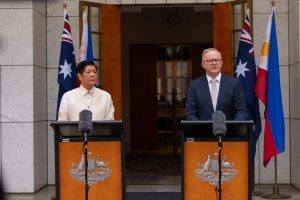Ahead of next week’s Australia-ASEAN summit in Melbourne, Philippine President Ferdinand Marcos, Jr. addressed a joint sitting of both houses of the Australian Parliament on February 29. The speech was symbolic of the increasingly close ties that Australia and the Philippines have developed over recent years. The election of Marcos in 2022 provided a more like-minded leader for Australia to engage with; his predecessor had sought closer ties with Beijing while pulling away from the United States, a shared ally of Australia and the Philippines.
Central to Marcos’ speech was Manila’s concern about China’s behavior in the South China Sea. The Philippines and China have been involved in often tense confrontations there in recent years. Beijing has not only used its navy and coast guard to intimate Manila, but also used extraordinary measures like informal militias housed on fishing vessels to push the Philippines to relinquish features within the South China Sea that international rulings have deemed rightly belong to the Philippines.
Marcos highlighted the gravity of China’s attempts to undermine rules and norms, not only for the Philippines but for all countries within Southeast Asia and those whose economic interests traverse the sea. The president stated: “The protection of the South China Sea, a critical global artery, is crucial to the preservation of regional peace and, I dare say, of global peace. We have an abiding interest in keeping our seas free and open and in ensuring unimpeded passage and freedom of navigation.”
Marcos was firm in stating that the Philippines “now finds itself on the front line against actions that undermine regional peace, erode regional stability, and threaten regional success.” He added, “The challenges that we face may be formidable, but equally formidable is our resolve. We will not yield.”
This language was indicative of the far more direct statements Manila has made toward China’s behavior recently. Adding to this, Marcos thanked Australia for its support, highlighting that this rule-breaking by Beijing “is why our strategic partnership has grown more important than ever.” Last November Australia and the Philippines engaged in their first joint naval patrol of Filipino waters in the region.
Following his address to Parliament, Marcos and Australian Prime Minister Anthony Albanese signed a new memorandum of understanding to further implement some of the key priorities of the Strategic Partnership that was agreed to in September last year. These priorities included further enhancing maritime cooperation with each other in light of the situation in the South China Sea, but also extended to collaboration on cybersecurity and the digital economy, and greater cooperation between the two country’s economic competition commissions. Australia also will provide $13 million to support reforms being made to the Filipino justice system.
While maritime concerns have become central to Australia’s relationship with the Philippines, as a large country in Australia’s neighborhood there is potential for far greater cooperation. As with most of Southeast Asia, Australia’s economic relationship with the Philippines is undeveloped. A lack of complementarities, and Australia’s economic reliance on exporting resources Southeast Asia already has, prevents these relationships from flourishing the way ties between neighbors ideally should.
However, in September last year Australia released its Southeast Asia Economic Strategy to 2040. The strategy identified the Philippines as a primary country for enhanced trade. The Philippines’ strong economic growth is clearly enticing. The strategy highlights some areas where Australia is hoping to excel – namely green technology and digital industries like software development. At present Australia continues to lag behind its OECD peers in these areas.
However, as the Philippines’ middle class grows, Australian agriculture will become more desired and affordable, as will interest in Australia’s education system. In recent years around 17,000 Filipino students have studied in Australia, although recent visa changes targeting students may now reduce this figure. Filipinos have become Australia’s fourth largest diaspora community, now numbering around 400,000 people, holding the potential to drive commerce between the two countries.
The huge infrastructure deficit in Southeast Asia and the Philippines specifically presents an opportunity to enhance relations outside of maritime security. While Australia may lack the funds of countries like Japan that are heavily investing in major projects throughout the region, Australia’s technical nous and more targeted infrastructure investments would be a welcome addition to the Philippines, where the needs are considerable.
Providing the Philippine president the honor of addressing the Australian Parliament was more a statement of intent than one recognizing a long-standing intimacy between the two countries. It was most likely also a signal to Beijing that the two countries will find ways to forge closer bonds as a result of Chinese actions in the South China Sea. It was a way to demonstrate that when peace is threatened, those who value its maintenance will find ways to build greater bonds of cooperation and trust.

































